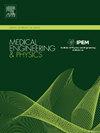Effect of plantar fascia stiffness on plantar windlass mechanism and arch: Finite element method and dual fluoroscopic imaging system verification
IF 1.7
4区 医学
Q3 ENGINEERING, BIOMEDICAL
引用次数: 0
Abstract
This study explored the relationship between the foot arch stiffness and windlass mechanism, focusing on the contribution of the posterior transverse arch. Understanding the changing characteristics of foot stiffness is critical for providing a scientific basis for treating foot-related diseases. Based on a healthy male's computed tomography, kinematic, and dynamics data, a foot musculoskeletal finite element model with a dorsiflexion angle of 30°of metatarsophalangeal joint was established. Analyze the changes in stress distribution of the plantar fascia, metatarsophalangeal joint angle, arch height, and length during barefoot walking as the stiffness of the plantar fascia varies from 25 % to 200 %. For validation, the simulated arch parameters were compared with the dual fluorescence imaging system measurements. The width of transverse arch, height, and length of longitudinal arch measured by the dual fluorescence imaging system were 45.14 ± 1.63 mm, 29.29 ± 1.57 mm, and 155.16 ± 2.69 mm, respectively. The results of the simulation were 46.51 mm, 29.96 mm, and 156.71 mm, respectively. With the increase of plantar fascia stiffness, the effect of the windlass mechanism increased, the flexion angle of the metatarsophalangeal joint decreased, the distal stress of plantar fascia decreased gradually, while the proximal and middle stress increased, the transverse arch angle increased, but when the plantar fascia stiffness exceeds 150 %, the transverse arch angle decreases. The increase of plantar fascia stiffness will increase the effect of the windlass mechanism but decrease the flexion angle of the metatarsophalangeal joint. The stiffness of the plantar fascia influences the behavior of the plantar fascia. The plantar fascia stiffness affects the distal tension of the plantar fascia by affecting the flexion of the metatarsophalangeal joint in the plantar windlass mechanism. It affects the stiffness of the transverse arch of the foot together with the ground reaction force acting on the distal metatarsal.
足底筋膜硬度对足底辘轳机制和足弓的影响:有限元法和双透视成像系统验证
本研究探讨了足弓硬度与辘轳机制之间的关系,重点关注后横弓的贡献。了解足部僵硬度的变化特征对于为治疗足部相关疾病提供科学依据至关重要。根据健康男性的计算机断层扫描、运动学和动力学数据,建立了跖趾关节背屈角度为 30°的足部肌肉骨骼有限元模型。分析赤足行走时,足底筋膜应力分布、跖趾关节角度、足弓高度和长度在足底筋膜硬度从 25% 到 200% 变化时的变化。为了进行验证,模拟的足弓参数与双荧光成像系统的测量结果进行了比较。双荧光成像系统测量的横向足弓宽度、高度和纵向足弓长度分别为 45.14 ± 1.63 毫米、29.29 ± 1.57 毫米和 155.16 ± 2.69 毫米。模拟结果分别为 46.51 毫米、29.96 毫米和 156.71 毫米。随着足底筋膜刚度的增加,辘轳机制的作用增大,跖趾关节屈曲角减小,足底筋膜远端应力逐渐减小,而近端和中部应力增大,横弓角增大,但当足底筋膜刚度超过 150 % 时,横弓角减小。足底筋膜硬度的增加会增加辘轳机制的作用,但会减小跖趾关节的屈曲角。足底筋膜的硬度影响足底筋膜的行为。足底筋膜硬度通过影响足底辘轳机制中跖趾关节的屈曲来影响足底筋膜的远端张力。它与作用在跖骨远端上的地面反作用力一起影响足部横弓的硬度。
本文章由计算机程序翻译,如有差异,请以英文原文为准。
求助全文
约1分钟内获得全文
求助全文
来源期刊

Medical Engineering & Physics
工程技术-工程:生物医学
CiteScore
4.30
自引率
4.50%
发文量
172
审稿时长
3.0 months
期刊介绍:
Medical Engineering & Physics provides a forum for the publication of the latest developments in biomedical engineering, and reflects the essential multidisciplinary nature of the subject. The journal publishes in-depth critical reviews, scientific papers and technical notes. Our focus encompasses the application of the basic principles of physics and engineering to the development of medical devices and technology, with the ultimate aim of producing improvements in the quality of health care.Topics covered include biomechanics, biomaterials, mechanobiology, rehabilitation engineering, biomedical signal processing and medical device development. Medical Engineering & Physics aims to keep both engineers and clinicians abreast of the latest applications of technology to health care.
 求助内容:
求助内容: 应助结果提醒方式:
应助结果提醒方式:


